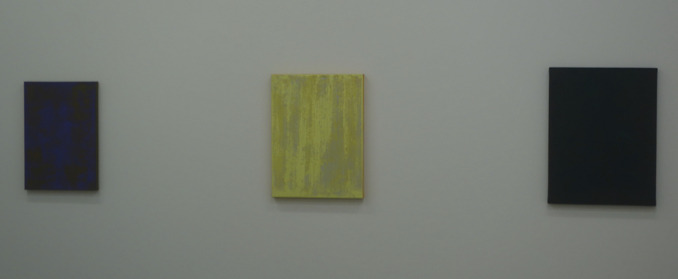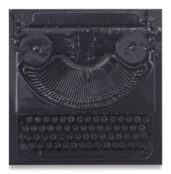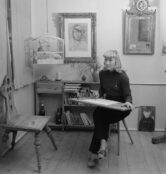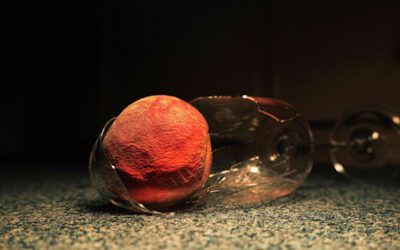[dropcap style=”font-size:100px; color:#992211;”]A[/dropcap] delightful solo exhibition by the painter Gérard Traquandi is currently showing at Laurent Godin in Olympiades, south east Paris.
The gallery is vast and whilst Traquandi is the focus of the current show it is presented with surrounding spaces showcasing Laurent Godin’s stable of young up and coming artists.
Traquandi is an old school modernist painter, if that can be permitted. The paintings are processed and show clearly the layering and dragging we might expect of postmodern painters such as Gerhard Richter. However, like modernist process painters, Traquandi is not centrally concerned with representation. Indeed, to all intents and purposes, the works are abstract. Like many abstract painters, however, the layering sets up a reading of spatial depth both in front of and behind the picture plane.
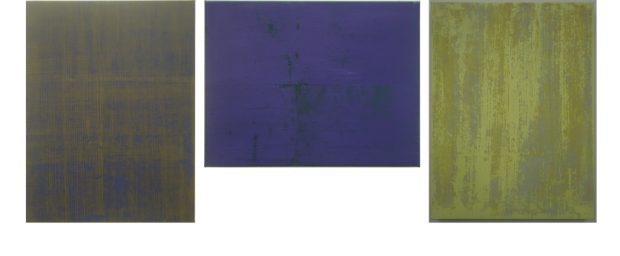
Gérard Traquandi, Three paintings at Galerie Laurent Godin
His use of colour is simply superb; and it is easy to imagine Clement Greenberg enthusing over their finesse.
Greenberg claims the formalism he advocated derives from Kant. However, that would be a misreading of Kant’s aesthetics; or, at best, an unwarranted manipulation of it.
It is notable here to consider Kant’s conception of pure beauty or free beauty. For Kant’s formalism regards such beauty as free from concepts and therefore, purely formal. I see the carapace of a nautilus as (something like) a mathematical sequence of spiralling form, increasing in size, according to the golden section. Crucially, Kant does not consider colour as form, but instead, a delight – merely pleasant.
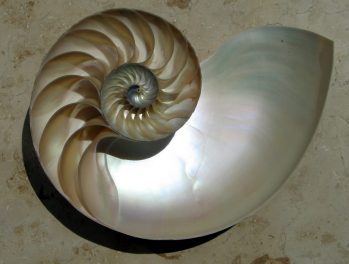
Nautilus cutaway revealing logarithmic structure
[A] judgment of taste is pure only insofar as no merely empirical liking is mingled in with the basis that determines it. But this is just what happens whenever charm or emotion have a share in a judgment by which something is to be declared beautiful.[1]
And a little further he adds,
[I]n all the visual arts (…) design is what is essential; in design the basis for any involvement of taste is not what gratifies us in sensation, but merely what we like because of its form. The colours that illuminate the outline belong to charm. Though they can indeed make the object vivid to sense, they cannot make it beautiful and worthy of being beheld.[2]
In judging the carapace beautiful, I may need to apprehend in sight, the coloured manifestation of the object. But in the judgment of beauty, according to Kant, it is the structure of the carapace alone that I find beautiful in my apprehension of it.
Greenberg chose to ignore that Kant thinks of the fine arts in general, and of painting in particular, as dependent beauties. That is to say that Kant thinks governing concepts are to be admitted in the judgement. When I look at the beauty of the carapace of the nautilus does not depend upon my conception of what a nautilus is nor what purpose it serves. Indeed, these concepts have to bracketed out from the experience if I am to judge the carapace beautiful.
In the fine arts, however, we need to bring to bear the concept under which the thing we look at, or read, or listen to, in order to come to a judgement. Colour whist making its bearers ‘vivid to sense,’ is not merely formless sensation, as Kant might have us believe. Rather, as Wittgenstein reminds us, it exhibits structure, and hence form, of its own.
-
-
I want to say there is a geometrical gap, not a physical one, between green and red. [Z354.] [3]
-
We have a colour system as we have a number system.
-
Do the systems reside in our nature or in the nature of things? How are we to put it? – Not in the nature of numbers or colours. [Z357][4]
-
“Just now I looked at the shape rather than the colour.” Do not let such phrases confuse you. Above all, don’t wonder “What can be going on in the eyes or brain here?” [PI, II, xi, p. 211c][5]
-
“The echo of a thought in sight” – one would like to say. [PI, II, xi, p. 212b][6]
If colour admits of a quasi-geometric structure, then abstract painting of the kind Traquandi pursues can exploit this feature. Wittgenstein has other interesting things to say about out apprehension of the visible world.
33. We speak of the ‘colour of gold’ and do not mean yellow. “Gold-coloured” is the property of a surface that shines or glitters.[7]
Not only does colour fit into a geometric space (the colour sphere with its monochromatic axis); but it also admits textures and surface qualities that we see, even as we notice the colour hasn’t changed. (Imagine looking at a red glossy surface that has, in part had its gloss taken off. The same colour: different surfaces will show up in sight.)
Tranquardi uses a variety of surface properties as he layers his colours so that the colour geometry is enhanced by and enhances, the surface properties of his delicate compositions. The works on display at the gallery are very beautiful indeed.
[1] Emmanuel Kant, Critique of Judgment, (trans.), Werner S. Pluhar, Indiana: Hackett Publishing, 1987, 224.
[2] Ibid., 225.
[3] Wittgenstein, L (1980b), Remarks on the Philosophy of Psychology, (volume II), Oxford: Basil Blackwell
[4] Wittgenstein, L (1980b), Remarks on the Philosophy of Psychology, (volume II), Oxford: Basil Blackwell
[5] Wittgenstein, L (1982), Last Writings on the Philosophy of Psychology, Oxford: Blackwell
[6] Wittgenstein, L (1982), Last Writings on the Philosophy of Psychology, Oxford: Blackwell
[7] Wittgenstein, L (1975), Remarks on Colour, Berkeley and Los Angeles: University of California Press
Nautilus image is from the user Chris 73 and is freely available at //commons.wikimedia.org/wiki/File:NautilusCutawayLogarithmicSpiral.jpg under the creative commons cc-by-sa 3.0 license.
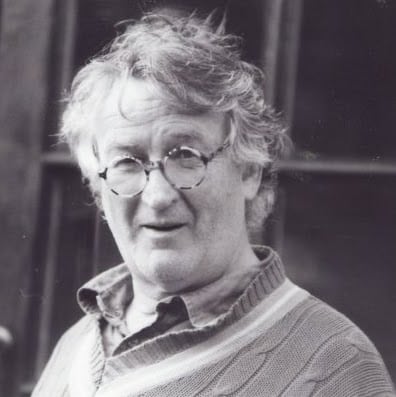
Ed studied painting at the Slade School of Fine Art and later wrote his PhD in Philosophy at UCL. He has written extensively on the visual arts and is presently writing a book on everyday aesthetics. He is an elected member of the International Association of Art Critics (AICA). He taught at University of Westminster and at University of Kent and he continues to make art.

